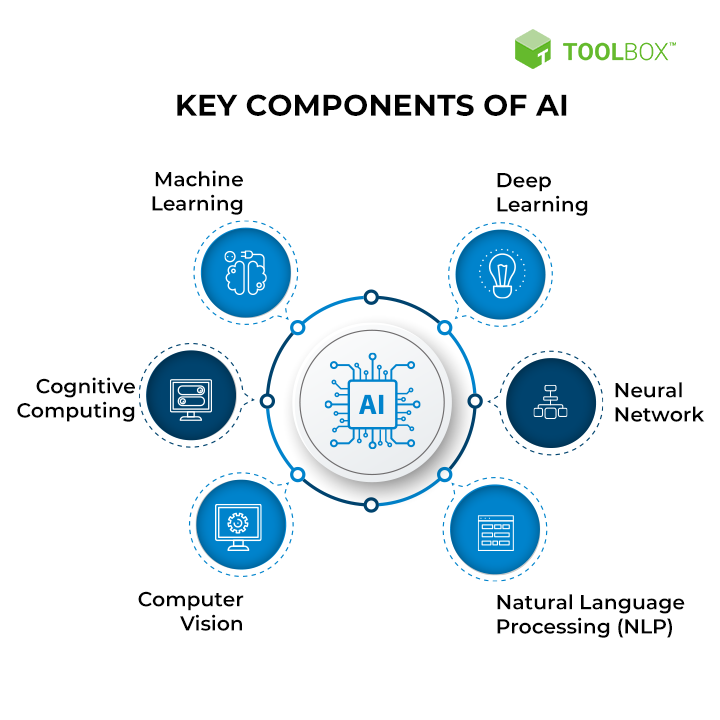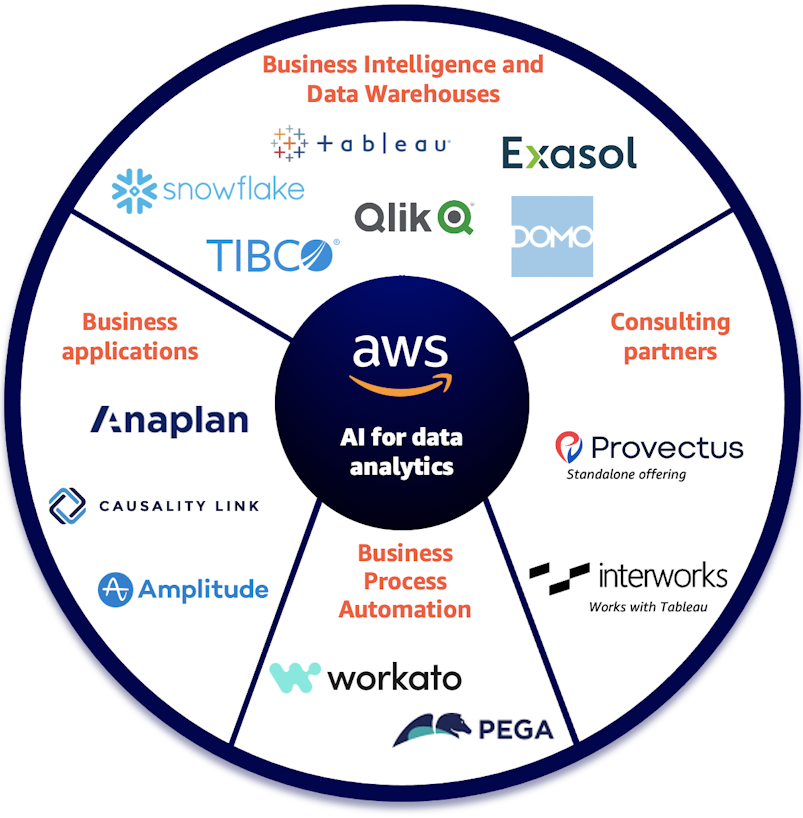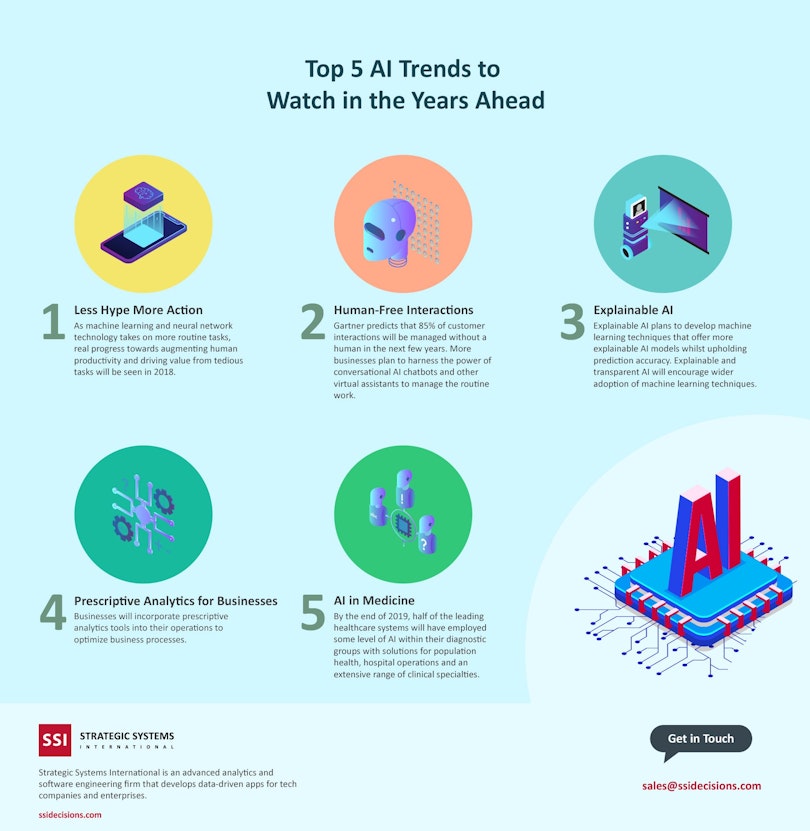In an era where data surpasses currency in value, Artificial Intelligence (AI) has become crucial in business analytics. AI and Machine Learning are transforming data analysis by rapidly processing vast data volumes, revealing insights that were once beyond reach. This shift from time-intensive manual analysis to automated AI-powered analytics allows businesses to concentrate on strategic innovation, identifying patterns and trends within their data more efficiently.
AI tools have revolutionized data analytics, making advanced analysis accessible to startups and established enterprises alike without needing extensive technical expertise. AI offers endless potential in business analytics - from improving operational efficiency to driving strategic growth; its promise lies within data-driven decisions propelling businesses toward unprecedented success.
As we explore AI in business analytics, it becomes apparent that our journey has just begun. AI's combination with business analytics represents a trend and a fundamental transformation of how businesses operate, innovate, and compete in today's digital environment.

AI in Business Analytics Is Changing
From Traditional Analytic to AI-Driven Insights
The move away from traditional business analytics toward AI-powered insights marks an exciting transition in business decision-making. Traditional methods, including spreadsheet analyses and manual data interpretation, laid the groundwork for business intelligence but often fell short regarding speed, accuracy, or depth of insight. AI and machine learning have led to an age where such constraints are rapidly dissolving away.
AI-driven analytics harness the power of advanced algorithms and computational processing to analyze complex datasets at unprecedented speeds. The MIT Technology Review article on the impact of AI on business analytics further explores how this acceleration speeds up the analysis process and enhances the accuracy of insights speeding up both the analysis process as well as providing more accurate insights.
AI integration in business analytics tools has made predictive analytics more accessible, allowing businesses to predict market changes, customer behavior changes and business risks with impressive accuracy.
Key AI Technologies Powering Business Analytics
Business analytics are being transformed by several key artificial intelligence (AI) technologies that contribute to more sophisticated, predictive, and efficient analysis processes. Understanding these technologies is imperative for business owners, marketers, and analysts to maximize AI's full potential within their strategies.
Machine Learning and Predictive Analytics
Machine Learning (ML) and Predictive Analytics are crucial technologies at the forefront of AI-powered business analytics, offering a range of benefits that help businesses optimize their operations and make more informed decisions. Here are the key functions highlighted:
Autonomous Data Learning: They empower machines to learn from historical data autonomously, continuously enhancing their predictive capabilities without human input.
Identification of Patterns and Trends: These technologies are adept at uncovering complex patterns within large datasets, providing businesses with deep insights into customer behavior and market dynamics.
Future Predictions: ML algorithms leverage past data to forecast future outcomes, trends, and behaviors with high precision, enabling proactive decision-making.
Gaining a Competitive Edge: The ability to predict market changes, consumer preferences, and potential risks gives businesses a significant advantage over competitors.
Inventory Management: Predictive analytics use historical sales data to accurately forecast demand, helping companies manage inventory more efficiently and reduce waste.
Enhanced Risk Assessment: Particularly in finance, ML models offer a more accurate assessment of loan default risks by analyzing customer transactions, leading to smarter lending decisions.
Incorporating Machine Learning and Predictive Analytics into business analytics allows companies to make informed, data-driven decisions, optimizing operations, and enhancing customer satisfaction through predictive insights.
Natural Language Processing for Improved Data Interpretation
Natural Language Processing (NLP) is a transformational AI technology that greatly enhances business analytics by enabling machines to understand and process human language. These are the primary benefits it can provide for improved understanding of data:
Understanding Human Language: NLP provides computers with the capability to comprehend, read and translate human speech and make sense of unstructured data such as reviews from customers as well as social media posts and responses to surveys.
Information on Customer Sentiments: By analyzing vast volumes of text that is unstructured, NLP gives deep insight into customer preferences, attitudes and patterns that may be overlooked by conventional analytics tools.
Automating Customer Feedback Analysis: NLP is a method of analyzing and collecting feedback from different platforms, giving a comprehensive overview of satisfaction levels and identifying areas of improvement.
Real-time Sentiment Analysis: It allows businesses to detect consumer moods in real-time which allows quick adjustments to strategies, product improvement as well as improvements to customer service.
Improved Customer Experiences: With a thorough analysis of sentiment and interpretation of feedback, NLP aids businesses in developing their products and services which results in better customer experience and customer satisfaction.
Utilizing Natural Language Processing for data interpretation, businesses can gain valuable insights from unstructured information as well as automate and streamline analytics processes and dramatically improve customer engagement and decision-making strategies.

Implement AI into Your Business Analytics Strategy in 3 Steps
Integrating AI into your business analytics strategy may seem intimidating at first, but its rewards in terms of insights, efficiency, and competitive advantage can be significant. Here is a practical guide for starting AI integration, navigating common hurdles, and taking advantage of advanced models like ChatGPT for competitive analytics.
Implementing AI in Business Analytics: Do This First
Before diving into AI, it ensures our data infrastructure can support it. is crucial this involves an effective data collection and management system that ensures data quality and accessibility?
1. Identify Key Areas for AI Application: Determine which aspects of your business could benefit most from AI-powered analytics. The McKinsey & Company guide on Implementing AI in Business Analytics provides strategic frameworks for identifying and capitalizing on these areas including customer segmentation, sales forecasting, operational efficiency improvements, or any other area where data-driven insights could make a tangible difference.
2. Identify Appropriate Tools and Partners: Select AI tools and platforms that align with the needs and goals of your business, such as those listed here: Top 20+ AI Tools Every Startup Business Must Have as a guideline. Partnering with AI experts or vendors may also offer invaluable guidance and support.
3: Launch a Proof of Concept (PoC) Project: Take small steps toward AI implementation by initiating a pilot project first, such as using a PoC to assess its ROI potential without having to devote extensive resources up-front.
Common Challenges with Implementing AI in Business Analytics
Data Privacy and Security: Implementing AI requires handling sensitive information. Ensure compliance with data protection regulations, and follow best practices in data security to build trust among your customers.
Skill Gaps and Training: Integrating AI may require skillsets not currently possessed by your team, which makes investing in training or hiring new talent vital for making effective use of it.
AI in Business Analytics: Tools and Platforms
As it pertains to business analytics, selecting the appropriate tools and platforms can have a dramatic impact on both insights gained and operational efficiency. Artificial Intelligence technologies have produced an array of AI-powered tools designed to streamline analytics processes, enhance decision-making abilities, and provide predictive analyses - here we explore some leading AI platforms essential for any company wishing to harness its power for analytics purposes.
AI Tools for Improved Business Analytics
Data Visualization and Interpretation: Tools like Tableau and Power BI offer AI features to assist businesses in visualizing complex datasets more intuitively. The Gartner report on Critical Capabilities for Analytics and Business Intelligence Platforms evaluates how these and other tools make data more accessible and actionable for decision-makers. Users of these platforms can identify trends, patterns, or anomalies quickly to make data actionable for decision-makers.
Machine Learning Platforms for Predictive Analytics: Platforms like TensorFlow and PyTorch offer machine learning libraries and tools for creating predictive models to identify market trends, customer behavior patterns, and operational risks in real-time allowing businesses to make proactive decisions with confidence.
Natural Language Processing for Customer Insights: IBM Watson and Google Cloud Natural Language are excellent tools for the analysis of text data such as customer reviews, social media comments, and support tickets. By understanding customer sentiment and queries, businesses can tailor their strategies to better meet customers' needs and ensure greater satisfaction.
AI Tools for Automating Analytical Tasks: Tools such as UiPath and Automation Anywhere incorporates AI technology to perform routine data processing tasks automatically, freeing human analysts to focus on strategic analysis and decision-making tasks.

AI and Business Analytics: The Future Trend
As we explore the future of business analytics, advances in AI technologies appear inescapably linked. Not only will these innovations improve current capabilities but they may also open up opportunities for innovation and strategic decision-making - understanding these trends is essential if businesses want to stay ahead of an increasingly digital environment.
Trends to Watch in AI and Business Analytics
Explainable AI (XAI): As AI systems become an ever-increasing component of business operations, demand for transparency in decision-making processes increases exponentially. Explainable AI strives to make AI models more interpretable so businesses can understand and trust insights provided by AI systems - something crucial for regulatory compliance, ethical considerations, and strategic decision-making processes.
AI-Driven Real-Time Analytics: Real-time data analysis is becoming ever more essential to modern businesses, providing businesses with an agile response to market changes, customer behavior shifts, and operational challenges that arise quickly. Future AI tools will offer businesses additional capabilities for processing and analyzing streams instantaneously - giving businesses more agility in responding to changes in markets, customer behavior, or operational challenges as they arise.
Augmented Analytics: Augmented analytics uses AI and machine learning (ML) technologies to automate data preparation, insight generation, and explanation processes. This trend promises to democratize data analytics by making complex findings easily accessible for non-expert users within organizations, thus expanding analytics-driven decision-making within them.
Integrating AI and IoT for Increased Insights: The Internet of Things (IoT) generates massive amounts of data through connected devices. Integrating AI with this IoT information can reveal insights into customer behavior, operational efficiency, and product performance - giving businesses a holistic view of their ecosystem.
Ethical AI and Bias Mitigation: As AI assumes more decision-making roles, its ethics become even more crucial to ensure it makes unbiased choices that serve all stakeholders equally. Future advancements will focus on ethical frameworks and techniques designed to identify and minimize biases present in AI models to achieve equitable outcomes for all involved.
AI and Edge Computing: Edge computing processes data closer to its source, reducing latency and bandwidth use. By integrating AI with edge computing, faster-localized decision-making can occur faster - essential in time-sensitive industries like manufacturing, healthcare, and retail.
Prepare for an AI-Driven Analytics Future
To take advantage of these trends shortly, businesses should:
Promote AI Literacy: Build awareness of artificial intelligence technologies throughout your organization to create an environment in which AI-generated insights are valued and utilized effectively.
Stay Agile: Be ready to adjust quickly to AI analytics that provides real-time updates of business strategies, so your organization remains resilient and competitive.
Prioritize Ethical Considerations: Establish guidelines and practices for ethical AI use that emphasize fairness, transparency, and accountability to foster trust between consumers and stakeholders.
Explore Partnerships and Collaborations: Engage with AI technology providers, research institutions, and industry consortia to stay at the forefront of AI advancements and applications.
To gain more insight into how AI is changing business analytics, check out AI-Powered UX Research: Ultimate Guide To Future Trends which offers insight into emerging AI technologies and their effect on user experience research.
AI in business analytics isn't simply about technological progress; rather, its use should focus on creating meaningful business outcomes, improving decision-making processes, and fortifying sustainable competitive advantages.

Conclusion: Leveraging AI for Business Analytics
Artificial Intelligence (AI) technology has brought about a sea change in how companies approach data, insights, and decision-making. We've explored how machine learning, natural language processing, and predictive analytics technologies such as machine learning have revolutionized business intelligence to offer unprecedented accuracy, efficiency, and strategic depth.
Harnessing AI to drive data-driven decision-making will become the key differentiator for organizations aiming to thrive in today's digital economy. By using AI tools and technologies strategically and wisely, organizations can unlock unprecedented levels of insight, efficiency, and innovation. To further explore the strategic use of AI in analytics, Unleash Your Creativity With AI Tools for UX Design provides an in-depth look at how AI tools are reshaping the landscape of user experience design. for a global perspective on leveraging AI for business analytics look for unprecedented levels of insight, efficiency, and innovation.
For those curious about exploring advanced AI features and their use in business analytics further, Beyond The Basic Conversation: How To Use ChatGPT Plugins provides a glimpse of AI-powered analytics tools that could potentially provide greater insights and a competitive edge. Our journey with AI business analytics has only just begun and the possibilities for advancement are limitless!




